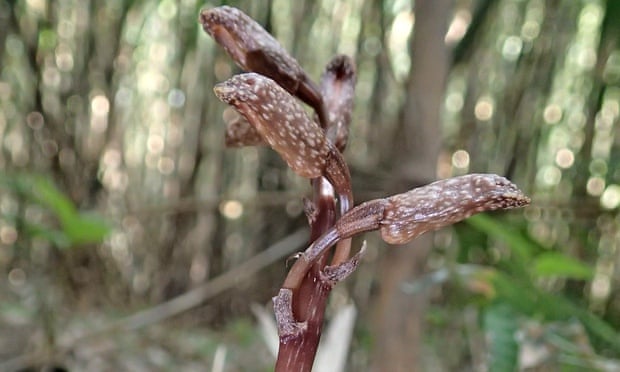
Many evolutionary biologists, including Charles Darwin in Fertilisation of Orchids (1862), have written about the bizarre and improbable contrivances by which orchids attract insect pollinators. Some orchids go so far as to mimic a female insect in appearance to attract an amorous male as an unwitting partner in pollination. A recently discovered orchid, Gastrodia flexistyloides, takes a very different approach. Like the similar G. flexistyla, it has a three-lobed column bearing the pollen. Two lobes are upright while the third is sharply curved in – and downward. There is a very good reason for this. These orchids are self-pollinating. Moreover, their flowers are cleistogamous. That is, the sexual bits are tightly enclosed within flowers that never open.
In many cleistogamous flowers the meeting of the gametes relies solely on gravity, pollen dropping within the flower. In the case of these species they do not have as far to fall, the sharply bent structure virtually assuring that self-pollination occurs. Clever variation on the system.
The species was described by Kenji Suetsugu of the Graduate School of Human and Environmental Studies, Kyoto University. It was found in bamboo forest on Takeshima Island, Japan, predictably within the geographic range of the genus. The other 50 Gastrodia orchids are found in tropical and temperate areas of Asia, Oceania, and Madagascar.
Like other members of the genus, the new orchid is a parasite. Technically, it is described as a myco-heterotroph, a plant that derives its nutrients from fungi. Unlike the more familiar symbiosis between fungi and tree roots by which there is a network of give-and-take exchange of nutrients, Gastrodia species extract what they require from the fungus but so far as is known contribute nothing in return.
Gastrodia flexistyloides differs from G. flexistyla in a few important details. Specifically, the new species sends up a taller stalk when flowering, has consistently and completely cleistogamous flowers, and shows a perianth that is both narrower and smaller. Suetsugu observed hundreds of individual plants during the period of flowering from mid-March until late April, all of which bore unopened flowers. At nine to 18 cm, the inflorescence of the new species is just a bit larger than an average member of the genus. Record sizes are about 3 cm at the short end and 100 cm at the tallest. The exchange of pollen between these two, Suetsugu argues, is simply impossible due to this anatomical chastity belt. Reasonable as far as it goes, it does raise some other questions about whether there is a single evolutionary origin of such a plant.
Like other Gastrodia, the new one has a fleshy tuber or underground stem and is conspicuously devoid of leaves. I cannot mention orchid tubers without reference to an old wives’ tale. Certain orchid tubers are shaped like testicles, and it has been long claimed that, when consumed, they are an aphrodisiac. This is, of course, a load of bollocks.